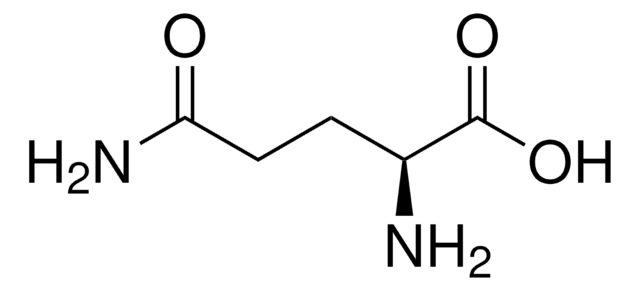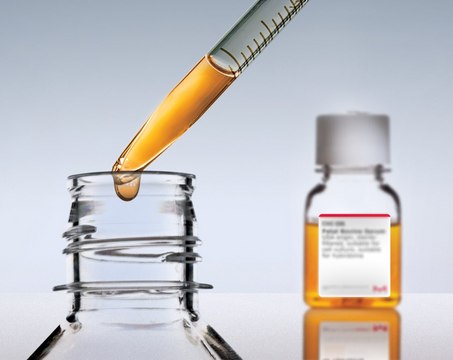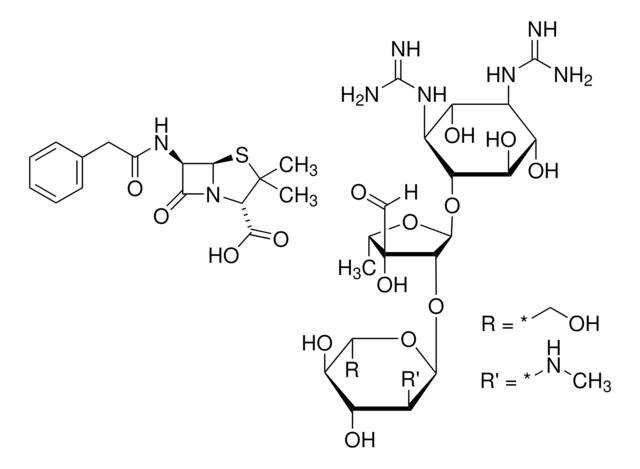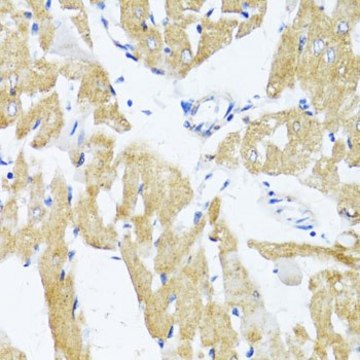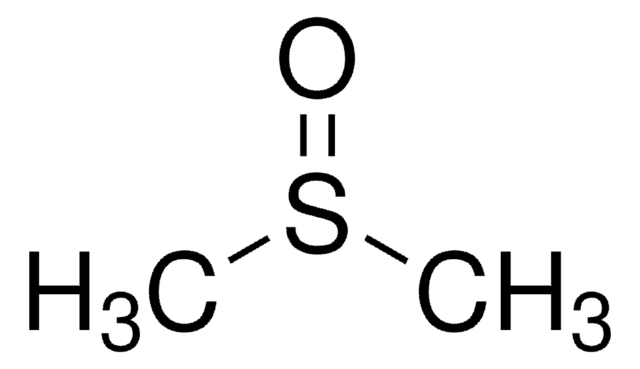推荐产品
生物来源
rabbit
质量水平
偶联物
unconjugated
抗体形式
affinity isolated antibody
抗体产品类型
primary antibodies
克隆
polyclonal
表单
buffered aqueous solution
分子量
antigen ~58 kDa
种属反应性
mouse, human
浓度
~1.5 mg/mL
技术
indirect immunofluorescence: 15-20 μg/mL using C2C12 cells
western blot: 1-2 μg/mL using C2C12 cell lysate and HepG2 cell lysate
UniProt登记号
运输
dry ice
储存温度
−20°C
靶向翻译后修饰
unmodified
基因信息
human ... SLC2A4(6517)
mouse ... Slc2a4(20528)
rat ... Slc2a4(25139)
一般描述
The GLUT4 (glucose transporter 4) gene, also known as SLC2A4 (solute carrier family 2 member 4) is mapped to human chromosome 17p13.1.The expression of GLUT4 (glucose transporter 4) is the highest in skeletal and adipose tissue.
应用
Anti-GLUT4 (C-terminal) antibody may be used for immunoblotting at a working concentration of 1-2 μg/ml in whole cell lysate of C2C12 and HepG2 cells. A working dilution of 1:3000 was used for immunoblotting in whole cell lysate of HEK-293 cells. . Anti-GLUT4 (C-terminal) antibody has also been used for immunoblotting in CHO-K1 cells. Antibody concentration of 15-20 μg/ml is recommended for immunofluorescence in C2C12 cells.
Anti-GLUT4 (C-terminal) antibody produced in rabbit has been used in western blotting and immunofluorescence assay.
生化/生理作用
GLUT4 is an insulin-regulated glucose transporter that facilitates the uptake of glusose by fat and muscle cells. Generally restricted to storage vesicles, GLUT4 translocates to the plasma membrane in response to insulin stimulation. The vital function of GLUT4 is regulation of glucose utilization by the cells. Following meal consumption, insulin secreted by the pancreas binds to receptors on the muscle and adipose and activates the PI3K-Akt pathway. Activation of this pathway triggers the secretion of GLUT4 from the vesicles that translocate to the plasma membrane. An overall decrease in the expression of GLUT4 results in diabetes and a selective disruption of GLUT4, in skeletal or adipose tissue, results in insulin resistance
外形
0.01M 磷酸缓冲盐溶液,pH 7.4,含 15mM 叠氮化钠。
免责声明
Unless otherwise stated in our catalog or other company documentation accompanying the product(s), our products are intended for research use only and are not to be used for any other purpose, which includes but is not limited to, unauthorized commercial uses, in vitro diagnostic uses, ex vivo or in vivo therapeutic uses or any type of consumption or application to humans or animals.
未找到合适的产品?
试试我们的产品选型工具.
储存分类代码
10 - Combustible liquids
闪点(°F)
Not applicable
闪点(°C)
Not applicable
法规信息
常规特殊物品
历史批次信息供参考:
分析证书(COA)
Lot/Batch Number
Effect of tnf-alpha on caveolin-1 expression and insulin signaling during adipocyte differentiation and in mature adipocytes
Palacios OS, et al.
Cellular Physiology and Biochemistry, 36(4), 1499-1516 (2015)
Signaling, cytoskeletal and membrane mechanisms regulating GLUT4 exocytosis
Hoffman NJ and Elmendorf JS
Trends in Endocrinology and Metabolism, 22(3), 110-116 (2011)
Adelle C F Coster et al.
Traffic (Copenhagen, Denmark), 5(10), 763-771 (2004-09-10)
The insulin-sensitive glucose transporter GLUT4 mediates the uptake of glucose into adipocytes and muscle cells. In this study we have used a novel 96-well plate fluorescence assay to study the kinetics of GLUT4 trafficking in 3T3-L1 adipocytes. We have found
Endocrinological abnormalities are a main feature of 17p13. 1 microduplication syndrome: a new case and literature review
Maini I, et al.
Molecular Syndromology, 7(6), 337-343 (2016)
Alexander F Rowland et al.
Traffic (Copenhagen, Denmark), 12(6), 672-681 (2011-03-16)
One of the most important metabolic actions of insulin is catalysing glucose uptake into skeletal muscle and adipose tissue. This is accomplished via activation of the phosphatidylinositol-3-kinase/Akt signalling pathway and subsequent translocation of GLUT4 from intracellular storage vesicles to the
我们的科学家团队拥有各种研究领域经验,包括生命科学、材料科学、化学合成、色谱、分析及许多其他领域.
联系技术服务部门
